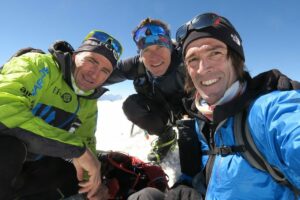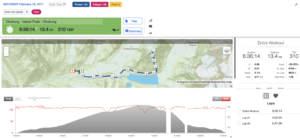
Our Training Philosophy Put to the Test
Aerobic Work Capacity! Why are we so focused on it?
Early in my athletic and coaching career, I connected some previously unconnected dots and had the proverbial aha moment that has shaped my training philosophy ever since. Over the past 30 years of achievements, personally and with our clients, that philosophy has stood the test of time.
Yet we still run into mountain athletes and coaches who continue to use training methods more suited to sport climbers and 5,000-meter runners because they think high-intensity training is a shortcut to long-duration endurance.
What does climbing high mountains look like from a metabolic standpoint? And, more importantly, what are the implications for training?
Several years ago, I collected data for some of the best alpinists in the world while they were doing a two-week training camp up at elevations from 15,000 feet (4600 meters) to 20,000 feet (6,100 meters) in the shadow of Mount Everest.
 High-altitude training: David Göttler running trails near Kongma La (18,135 feet/5,525 meters)
High-altitude training: David Göttler running trails near Kongma La (18,135 feet/5,525 meters)
I’ve shared this information in the past. Still, it is vital to get across that sharing this information again on the Evoke Endurance website will help others understand the importance of building the basic aerobic capacity for success as mountain athletes.
David Göttler, whom I am still coaching, and Üli Steck, whom I consulted with on his training before his sad death on Nuptse, both wore their heart rate monitors and uploaded the workouts so I could view them in near real-time. One of the first things I noticed was how low their heart rates were during all their runs and climbs. The average and peak heart rates were much lower than when they trained at home in the Alps.
 To prepare for upcoming spring climbing objectives, alpinist and Uphill Athlete David Götter, along with Hervé Barmasse and Üli Steck, wrapped up a three-week training camp in the Khumbu region of Nepal. This training block is part of the overall annual training strategy for these alpinists, and they build their annual training plans around it. It is an extension of a similar training period that David and Üli used in 2016 to prepare for their climb on Shishipangma.
To prepare for upcoming spring climbing objectives, alpinist and Uphill Athlete David Götter, along with Hervé Barmasse and Üli Steck, wrapped up a three-week training camp in the Khumbu region of Nepal. This training block is part of the overall annual training strategy for these alpinists, and they build their annual training plans around it. It is an extension of a similar training period that David and Üli used in 2016 to prepare for their climb on Shishipangma.
At the time, and still so today, I felt that presenting this data would help convince skeptical readers that there is something to this. Later in the article, I will provide the theoretical bases for my conclusions.
The Data
Below is a screenshot of the workout data download from the day they climbed Island Peak. The red line represents David’s heart rate. The gray is the elevation gain (about 1,500 meters), and the horizontal scale is time in hours and minutes. David’s Aerobic Threshold (AeT) is approximately 155 bpm at sea level. His maximum heart rate on this workout was 133. They were climbing at a controlled aerobic effort similar to how they would feel at home: gaining 1,500 meters in 2 hours and 40 minutes. After 15 minutes on the summit, his resting heart rate dropped to only 95 bpm, 50 beats above his low-elevation resting heart rate (indicating that he was not well acclimated). This gave him a minimal effective working range from 95 to 133 bpm. He better have an excellent low-end work capacity because he can’t access the high-intensity top end of his metabolism.

Heart rate data (in red on left scale) for David Göttler from February 18 climb of Island Peak, 20,275 feet/6,180 meters. Üli’s heart rate chart would look the same.
Physiological Mechanisms
There are several prevailing theories as to why this occurs:
- At high elevations (and the higher the elevation, the more pronounced the effect), the barometric pressure and, thus, the partial pressure of oxygen (PO2) of the atmosphere drops. This means that each breath contains fewer oxygen molecules than it does at a lower altitude. If you’ve been to even moderately high elevations, like 14,000 feet, you have no doubt noticed that your work rate/speed is significantly reduced. There just isn’t enough O2 to power sustained vigorous work. One of the upshots is that a well-trained heart has much more pumping capacity than is needed at these high elevations. Studies have shown that on the summit of Mount Everest, even if we had an unlimited cardiac output, our maximal work rate would remain unchanged due to the blood’s drop in oxygen content. The heart is a slave to the brain, which gets feedback from the muscles as to how much O2 is needed to sustain the work required. When the oxygen content of the air drops, the muscle power output necessarily drops with it, so the heart, in response to the lower power demands, cuts the cardiac output by lowering the heart rate.
- Additionally, the brain probably selects to prioritize the heart muscle over skeletal muscle for O2 delivery. If there is insufficient O2 to support higher cardiac output, the brain will limit the heart rate to ensure that the heart’s O2 demand does not outstrip its supply, or the consequences could be fatal. Couple this lower cardiac output with the lower oxygen content in each breath, and you’ve got the perfect storm where skeletal muscles, the ones propelling you up the mountain, simply don’t have enough oxygen to sustain high-intensity exercise.
- Due to the very high ventilation rate (breaths per step) required at these very high elevations, a great deal of blood will be shunted to the respiratory muscles. This, too, will leave less oxygen for the skeletal muscles.
Taken together, all three stack the deck against those leg muscles being able to get enough oxygen to power high-intensity movement. From this line of reasoning, it should be obvious why climbers at 8000m typically can ascend about 100 meters vertically per hour, whereas at sea level, 1000 meters/hour is not unusual
Training Implications
Here is the critical takeaway: With heart rates so limited, even these very well-trained athletes cannot operate at high intensities. They cannot work hard enough to get their heart rate into Zone 2, let alone Zone 3 or 4. They just can’t access the higher-power muscle fibers trained with high-intensity (high-heart-rate) workouts and which primarily consume glycogen for fuel. They are restricted to their humble slow twitch fibers, which rely almost exclusively on fat for energy. Our training goal is to get their pace at their Aerobic Threshold/top of Zone 2 as fast as possible because, at those altitudes, that is their top end metabolically.
Decades of evidence across the whole gamut of endurance sports shows that there is only one way to elevate your pace at the aerobic threshold. Hours upon hours, month after month, for year upon year of low to moderate-intensity training is required to boost this quality. This long-term consistent endurance training leads to dramatic increases in mitochondrial density in the muscle fibers and the aerobic enzymes responsible for aerobic metabolism. This type of training also results in a proliferation in the dense network of capillaries around those working muscle fibers. Hence, the oxygen has less distance to transit from capillary to mitochondria.
No amount of high-intensity training can provide the needed metabolic or structural adaptations for optimal performance at altitude. It simply works through an entirely different system. In the wrong dose, the high-intensity training that is often prescribed as training for mountain athletes, especially alpinists and mountaineers, can be detrimental to aerobic development. Nevertheless, I still see this ill-informed prescription used.
Performance Note
These alpinists cut 30 minutes off last year’s identical climb of Island Peak and felt much less tired when they returned to their lodge in Chukung. This represents a performance gain of over 8 percent for already very well-trained athletes in about eight months. We have seen improvements of over 30 percent in similar tests by less well-trained athletes we’ve coached.
Special thanks to Dr. Monica Piris, MD, and Dr. Scott Ferguson, Ph.D., for their help with this article.



 Facebook
Facebook

Thank you for posting such an informative article. Do you think the best way to improve AeT pace is to train at a point just below it? 80-90% of my training is spent below AeT, sometimes Zone 1 but I don’t always feel a training stimulus in those situations.
Interesting to see that RHR was nearly doubled for a well trained athlete at altitude.
Alex;
Yes, the best way to increase your aerobic capcity and hence your speed at your AeT is to train at and just below that intensity/pace/heart rate. Since I don’t know your specific situation these comments might not pertain. But, here goes:
The most common reason people say this intensity feels too easy and doubt that it could be having any effect is that they are aerobically deficient but have a good anaerobic work capacity from having done a lot of higher intensity training. Their legs are used to working harder than this AeT effort level so their perceived exertion will feel very easy. That’s because those same leg muscles can’t produce any more power than this resultant slow/easy pace without resorting to the anaerobic system and the FT fibers. If this is your situation, be aware that aerobic deficiency takes months and months of consistant high volume of Z2 work to correct. Volume of Z2 work is the single biggest stimulus to improving ADS. So, it is poossible you need to be more patient and/or need to add more volume in Z2. I hope this helps.
Scott
Hi.
Thanks for such great and detail walk through
You mentioned the training camp as a intermediate goal of some sort, if i understood correctly? you have mentioned this previously on UA.
I would love to hear more about this. If one has 5 weeks availabe, and have done 52 weeks of base training and have a major goal 3 months later. Could this work as transition into the specific phase?
How much volume relative to your biggest week in base?
Best regards,
Sorry to be slow. I thought I had replied earlier to this. I would suggest using the training camp idea as a significant block of specific training rather than a prep for the spcific period. If you can manage to do your “camp” in a terrain, altitude and event speicific place and manner you will get great benefit from it. Here is how I have used this idea in the past few years: David Goettler, Ueli Steck and Herva Barmasse would go to the Khumbu region and do a high volume of low intensity running and climbing. This allowed them to acclimate to the altitude and increase their aerobic work capacity in very event speicific ways. They would then return home to low elevation and finsh the final month or so of training before the big climb with high intensity work that they could not do at altitude. The increased red blood cells allowed them to get more benefit from this training.
Last year a month or so before the UTMB race where he placed 3rd Tom Evans did a “camp” where he ran the race course over several days. Staying in hotels but doing each section of the course at race pace, testing gear, clothes, food and hydration.
There are many ways to do this same thing. Back in the old days when I was a climber I would go to the Canadian Rockies (the best mountains for training in North America) and do or try to do several significant (for me) climbs before making a trip to the Karakoram of Himalaya. Same idea with less structure.
I hope this helps.
Scott